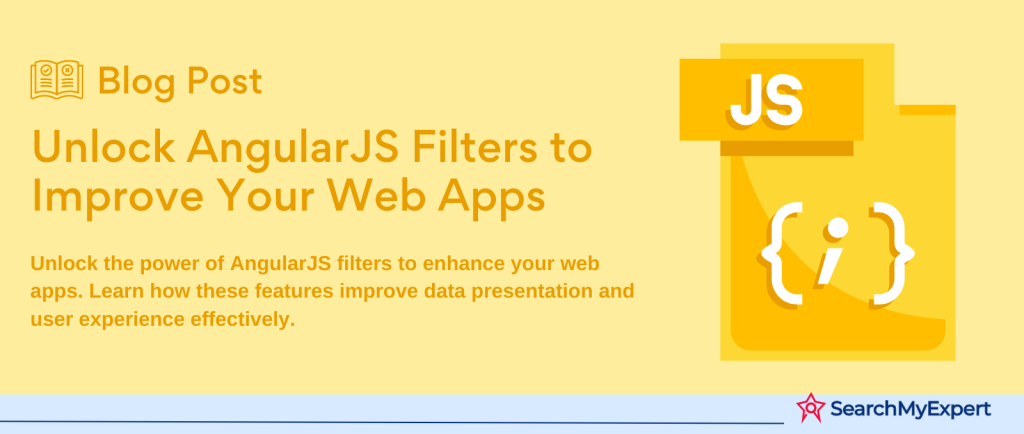Filters in AngularJS
In the world of web development, presenting data in a clear, concise, and user-friendly manner is paramount. AngularJS, a powerful framework by Google, enhances this aspect of development with a feature known as filters. Filters in AngularJS play a pivotal role in manipulating data directly within templates, enabling developers to transform, display, and format data seamlessly. This introductory guide delves into the core purpose of filters, their impact on data presentation and user experience, and provides a primer on their syntax and basic usage.
Core Purpose of Filters
Filters are designed to serve a critical function within AngularJS applications: manipulating data within templates for display, transformation, and formatting. They are the unsung heroes who work behind the scenes to ensure that the data presented to the end user is processed and formatted appropriately. Whether it’s sorting a list of names, changing text cases, filtering content based on specific criteria, or formatting dates and numbers, filters enable these tasks to be performed effortlessly within the template itself.
Enhancing Data Presentation and User Experience
The integration of filters into AngularJS templates significantly elevates the quality of data presentation and the overall user experience. Here are a few ways filters contribute to this enhancement:
- Readability and Accessibility: By transforming complex data into a format that’s easy to read and understand, filters make the information more accessible to users.
- Dynamic Data Manipulation:
Filters allow for the dynamic manipulation of data based on user interactions or specific conditions, without altering the original data source. This real-time data processing ensures that the information displayed is always relevant and up-to-date. - Customization and Flexibility:
With filters, developers can customize how data is presented to meet the unique needs of their application. This includes everything from basic text formatting to complex data transformations, providing a high degree of flexibility in how information is displayed.
Syntax and Basic Usage
Using filters in AngularJS is straightforward, yet powerful. The syntax involves appending a filter to a data-binding expression with a pipe (|) symbol, followed by the filter name. Filters can be used within HTML templates to apply transformations directly to data bindings, enhancing the presentation layer without the need for additional JavaScript code. This simplicity in syntax, combined with the powerful data manipulation capabilities, makes filters an indispensable feature in AngularJS for creating dynamic and user-centric web applications.
Built-in Filters in AngularJS
AngularJS provides a versatile set of built-in filters designed to handle common data manipulation tasks directly within templates. These filters range from formatting numbers and dates to ordering and filtering arrays. Understanding how to utilize these filters can significantly enhance the functionality and user experience of your AngularJS applications. Let’s explore some of the common and less common filters available in AngularJS and how they can be applied in real-world scenarios.
Common Filters
Currency
The currency filter formats numbers as currency values, making it essential for applications dealing with financial transactions. It ensures that numbers are displayed in a format familiar to the user, complete with currency symbols.
Date
The date filter allows for the formatting of date objects according to locale or a specified format string. This filter is invaluable for applications that need to display dates in a user-friendly manner, accommodating various regional preferences.
Filter
This filter is used to filter arrays based on a provided expression. It is particularly useful in scenarios where the user needs to sift through a list of items based on specific criteria, such as searching for products in an e-commerce application.
LimitTo
The limit filter restricts the number of items displayed from an array or the number of characters in a string. This can be useful for previewing snippets of text or limiting the display of items in a list to enhance user experience.
Lowercase, Uppercase
These filters transform the case of text, converting all characters to lowercase or uppercase, respectively. This functionality is handy for standardizing the appearance of user-generated content or search queries.
Number
The number filter formats numbers with specified decimals and rounding. It’s especially useful for displaying numerical data that requires precision, such as scientific measurements or statistical data.
OrderBy
The orderBy filter orders arrays based on specified properties and sorting options. It can sort lists of items alphabetically, numerically, or even by custom criteria, making it crucial for organizing displayed data in a logical manner.
JSON
The JSON filter serializes a JavaScript object into JSON format, aiding in debugging by allowing developers to easily display the structure of an object within the template.
Less Common Filters
GroupBy
This filter groups items in an array based on a selected property. It is useful for categorizing items, such as grouping products by category in an online store.
Where
The where filter allows for filtering array items based on multiple conditions. This can be useful in complex filtering scenarios where items must meet several criteria to be displayed.
Inline
The inline filter performs in-template transformations for complex scenarios. It’s a more advanced filter designed for specific use cases that require on-the-fly data manipulation.
Unique
The unique filter eliminates duplicate items from an array, ensuring that each item in a list is distinct. This is particularly useful in scenarios where data integrity and uniqueness are important, such as in a list of selectable options.
Providing Contextual Examples
- Currency Filter Usage:
An e-commerce website displays the price of products in the user’s local currency format, enhancing readability and comprehension. - Date Filter Scenario: A blog platform uses the date filter to format the publication dates of posts according to the locale of the reader, providing a localized and friendly reading experience.
- OrderBy Filter Example:
A music app utilizes the orderBy filter to sort songs in a playlist alphabetically by artist name, making it easier for users to find their favorite tracks.
Custom Filters in AngularJS
In the flexible and dynamic ecosystem of AngularJS, the ability to tailor your application to meet specific requirements is key. Custom filters stand out as a powerful feature, allowing developers to extend beyond the built-in filters and craft personalized solutions for data processing and formatting. Understanding how to create and leverage custom filters can significantly elevate the functionality and user experience of your AngularJS applications.
Creating Custom Filters
Custom filters in AngularJS are defined using JavaScript functions, integrating seamlessly into the framework’s declarative nature. The essence of creating a custom filter involves defining a function that accepts input data, processes or transforms this data according to specific logic, and then returns the modified data as output. This process is encapsulated within the AngularJS module system, ensuring that custom filters are both reusable and modular.
Syntax and Structure
The structure of a custom filter is straightforward yet powerful. It begins with the definition of a filter within an AngularJS module, specifying a name and a function that embodies the filter’s logic. This function takes the original data as its primary input and may accept additional parameters to influence its behavior, providing the flexibility to handle a wide range of data manipulation tasks.
Data Manipulation
At the heart of a custom filter is the transformation process, where input data is manipulated to produce a desired output. This could involve formatting text, filtering or sorting arrays based on complex criteria, or even transforming data structures for display. The ability to accept input data and additional parameters allows custom filters to be dynamically adjusted based on the application’s context, making them incredibly versatile.
Benefits and Use Cases
Custom filters offer a myriad of advantages, particularly in their ability to provide tailored data processing and formatting solutions. They empower developers to implement custom logic that might not be feasible with AngularJS’s built-in filters, addressing unique application requirements and enhancing data presentation.
Advantages
- Tailored Data Processing: Custom filters allow for the implementation of specific data transformation logic that perfectly suits the application’s needs.
- Reusability: Once defined, custom filters can be reused across different parts of an application, promoting code modularity and reducing redundancy.
- Enhanced User Experience: By enabling precise control over data presentation, custom filters can significantly improve how information is displayed to the user, making applications more intuitive and user-friendly.
Practical Scenarios
Custom filters prove indispensable in a variety of scenarios, such as:
- Complex Data Formatting: Applications requiring specialized formatting of data, like transforming JSON data into a human-readable format or custom date and time representations.
- Advanced Search and Filtering:
Implementing advanced search functionality that filters data based on multiple criteria or complex logic not covered by the standard filter filter. - Custom Sorting:
Sorting data in ways that require more than just alphabetical or numerical order, such as custom hierarchical structures or prioritization based on specific attributes.
Chaining Filters in AngularJS
AngularJS’s filter system is not only powerful due to its individual components but also because of its ability to combine multiple filters together, known as chaining. This feature enables developers to apply a sequence of transformations to data by using more than one filter in a single expression. Chaining filters allows for complex data manipulations and formatting to be achieved with minimal code, enhancing readability and functionality.
Combining Filters for Complex Transformations
Chaining filters in AngularJS involves applying filters sequentially, where the output of one filter becomes the input for the next. This process allows for intricate and multi-step data manipulations to be conducted within templates, directly affecting how data is presented to the user. The syntax for chaining filters is straightforward, using the pipe (|) character to separate each filter and its optional parameters.
The beauty of chaining lies in its simplicity and power. By combining filters, developers can perform complex data transformations that would be cumbersome to implement as a single custom filter. This method maintains code clarity and leverages the framework’s declarative nature.
Concrete Examples of Chaining Filters
Formatting Dates with Localization and Uppercase
Imagine an application that displays dates in a localized format and then converts the entire string to uppercase. This can be achieved by chaining the date filter with the uppercase filter. First, the date is formatted according to the specified locale or format string, and then the resulting text is transformed to uppercase, providing a clear, user-friendly date string that stands out.
Filtering and Ordering a List
Consider a scenario where you have a list of items that you want to filter based on a search term and then order alphabetically. By first applying the filter filter to narrow down the list based on the search term and then chaining the order filter, you can produce a list that is both relevant to the user’s search and organized alphabetically.
Filtering with ng-repeat in AngularJS
One of AngularJS’s most powerful features is its data-binding capabilities, particularly when combined with directives like ng-repeat for rendering lists. When filters are integrated with ng-repeat, it unlocks a dynamic way to present and manipulate lists based on user input or specific criteria, enhancing the interactivity and functionality of applications.
Data Binding and Filter Integration
The ng-repeat directive is AngularJS’s way of repeating a block of HTML for each item in an array or object. By integrating filters directly into ng-repeat, developers can dynamically control which items are displayed, based on the data passed to the filter. This seamless integration simplifies the development process, allowing for real-time updates to the list presentation as the underlying data changes or as filter criteria are adjusted.
How Filters Enhance ng-repeat
Filters can be used within ng-repeat to achieve various effects, such as searching, sorting, and formatting data dynamically. This integration provides a live bridge between the user interface and the application’s data model, ensuring that any changes in the filter input or the data source are immediately reflected in the list presented to the user.
Showcase: Code Examples
While specific code examples cannot be provided in this response, here’s a conceptual overview of how ng-repeat can be used with filters to manipulate list presentation:
Filtering a List Based on User Input
Imagine a list of products that a user can search through by typing a search term. By using ng-repeat with a filter, the list automatically updates to display only the products that match the search term. The filter is applied directly within the ng-repeat directive, using the search term from an input field as the filter criteria.
Sorting a List Alphabetically
To sort a list alphabetically, you can chain the orderBy filter with ng-repeat. This setup ensures that as items are added or removed from the list, or as the sorting criteria change, the displayed list updates instantly to reflect the current sort order.
Limiting Items Displayed in a List
When you want to limit the number of items displayed from a longer list, the limitTo filter can be used with ng-repeat. This approach is particularly useful for implementing pagination or simply restricting the amount of content loaded at one time for performance reasons.
Using Filters with Scope Variables in AngularJS
Filters in AngularJS offer a versatile way to manipulate and present data without changing the original data structure. When it comes to scope variables, which serve as the data model within AngularJS controllers and views, filters can be applied directly to these variables within expressions to format, sort, or conditionally display data in real time. This capability provides a significant advantage in creating dynamic and responsive web applications.
Filtering on Scope Variables
Applying filters to scope variables is a straightforward process that enhances the flexibility and power of AngularJS’s data-binding mechanism. By attaching filters directly to scope variables in the HTML template, developers can transform the data displayed to the end-user without modifying the underlying data model. This approach is particularly useful for tasks like formatting dates, numbers, and texts, or for filtering and sorting lists based on user input or other dynamic conditions.
Practical Use Cases
- Date Formatting: A common use case involves formatting JavaScript date objects into more readable formats. For example, displaying a user’s last login time in a “human-friendly” format directly in the view.
- Text Transformation:
Transforming text for display purposes, such as converting text to uppercase for titles or to lowercase for email addresses, ensures consistency and improves readability. - Dynamic Filtering: Applying the filter filter to a list of items bound to a scope variable allows for dynamic searching and filtering of the list based on user input, displaying only items that match the filter criteria.
- Numerical Formatting:
For financial applications, numbers can be formatted as currency, or decimal places can be adjusted dynamically, providing a clearer understanding of financial data.
Best Practices and Considerations
While filters in AngularJS provide a powerful tool for data manipulation and presentation, there are several best practices and considerations to keep in mind to ensure optimal performance and maintainability of your application.
Performance Considerations
- Use Filters Judiciously:
Overuse of filters, especially within ng-repeat directives or on large datasets, can lead to performance degradation. Filters are executed on every digest cycle, so their computational cost can add up quickly. - Limit to Essential Transformations:
Apply filters for essential transformations and avoid complex operations that could be handled more efficiently by the controller or a service.
Maintainability and Readability
- Custom Filters for Complex Logic:
For complex data transformations, consider creating custom filters. This keeps your HTML templates clean and improves the readability of your code. - Modularity and Reusability: Design custom filters to be modular and reusable across different parts of your application. This not only improves maintainability but also reduces code duplication.
Conclusion
The exploration of AngularJS filters reveals their indispensable role in enhancing data presentation and user interaction within web applications. By harnessing the power of both built-in and custom filters, developers are equipped with the capability to perform sophisticated data manipulations directly within templates, fostering a more dynamic and interactive user experience. From formatting dates and numbers to creating complex data transformations through chaining and applying filters to scope variables, the versatility of AngularJS filters cannot be overstated.
Revolutionize your frontend development with our Angular JS Development Service.
Table of Contents
Toggle






